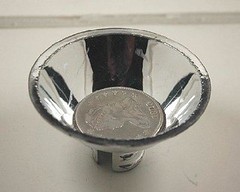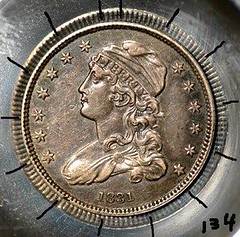
PREV ARTICLE
NEXT ARTICLE
FULL ISSUE
PREV FULL ISSUE
V11 2008 INDEX
E-SYLUM ARCHIVE
MORE ON COIN EDGE PHOTOGRAPHY
Inspired by our recent discussion of the topic, Steve M.
Tompkins submitted these thoughts on photographing the edge of coins.
-Editor
I was interested in the discussion about photographing the
edge of coins to be able to count the reeds. This is an area that has not
been fully explored with all coin series, but there have been a few
pioneers in this arena. The first and foremost is the late Russ Logan. Russ was always a proponent for looking at the "third" side of the coin. Russ was so enamored with this part of the coin that he designed and developed a specially prepared edge "mirror" which his company built. He determined the proper angle for the surface and had it ground to this angle then polished to a mirror like surface. Development of these edge mirrors was described in his paper "The Third Die: A Different Look" appearing in America's Silver Coinage 1794-1891 presented at the 1986 ANS Coinage of the Americas Conference.
John McCloskey has also been counting reeds on coins for many years and has published much information in the Gobrecht Journal for many different denominations and different years found in the Seated coinage. These counts can be used to distinguish specific collar dies used, which can aid in detecting counterfeits and those with mint marks added to create rare coins.
 For those not fortunate enough to own one of
these edge mirrors, the simplest and easiest way to count the reeded edge
of a coin is the one described by Bill Bugert in the last issue. However,
counting the reeds is much easier if you put the coin in this reflector
and shoot a picture using a copy stand and a digital camera. Once you have
taken the picture and downloaded it to a computer, it can be cropped and
resized to something slightly under 8 1/2 X 11, then printed out on any
inkjet or laser printer.
For those not fortunate enough to own one of
these edge mirrors, the simplest and easiest way to count the reeded edge
of a coin is the one described by Bill Bugert in the last issue. However,
counting the reeds is much easier if you put the coin in this reflector
and shoot a picture using a copy stand and a digital camera. Once you have
taken the picture and downloaded it to a computer, it can be cropped and
resized to something slightly under 8 1/2 X 11, then printed out on any
inkjet or laser printer. You can then easily mark the page starting at any reed, count any direction, and mark every 10th reed. After completing the full circumference of the coin then count how many marks you have and add any leftover reed under ten on the last place you counted. I used this device to count the reeded edges on all die marriages of the Bust Quarters for my new book on that series.
 One thing you need to keep in mind is that the
flashlight reflector needs to be at the proper angle for the reeds to be
shown well in the photograph. A larger, wider lens will not work as well
as one about 2" in diameter. As most of these are made out of plastic and
just chrome-plated to create the mirrored surface, they are easily
scratched and after repeated use need to be replaced with a new one.
One thing you need to keep in mind is that the
flashlight reflector needs to be at the proper angle for the reeds to be
shown well in the photograph. A larger, wider lens will not work as well
as one about 2" in diameter. As most of these are made out of plastic and
just chrome-plated to create the mirrored surface, they are easily
scratched and after repeated use need to be replaced with a new one.
Also, make sure that the reflector you choose has a smooth surface, as many cheap flashlight reflectors are now being made with multifaceted surfaces which can not be used for this purpose. I get the ones I use at the local Dollar Store, for the large sum of...$1! (Who says all things related to numismatics have to be expensive?)
Wayne Homren, Editor
The Numismatic Bibliomania Society is a non-profit organization promoting numismatic literature. See our web site at coinbooks.org.
To submit items for publication in The E-Sylum, write to the Editor at this address: whomren@gmail.com
To subscribe go to: https://my.binhost.com/lists/listinfo/esylum
All Rights Reserved.
NBS Home Page
Contact the NBS webmaster
